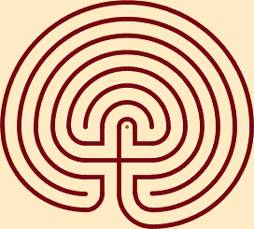Chapter 2. A Brief History of Wayfinding
Labyrinths and mazes are two distinct creatures. In the modern world, we are most familiar with the maze, an intricate and often confusing network of interconnecting pathways or tunnels designed to challenge the skills of all who enter. Mazes are multicursal. They offer a choice of paths, along with a disorienting mix of twists, turns, blind alleys, and dead ends. In a maze, it's hard to find your way and easy to become lost. In contrast, a true labyrinth is unicursal, like the one in Figure 2-1. There is one well-defined path that leads into the center and back out again. The labyrinth is an ancient symbol with a 3,500 year history in religion and mythology in such diverse places as Egypt, Peru, Arizona, Iceland, India, and Sumatra. It combines the imagery of circle and spiral into a meandering but purposeful path, a reassuring metaphor for our journey through life. In practice, we use the terms interchangeably. Our most famous labyrinth was really a maze, designed by the skillful architect Daedalus to entomb the Minotaur and its victims. Only by relying on Ariadne's ball of thread was Theseus able to escape after slaying the beast at the center. Like today's mazes of hedge and corn and ink, the labyrinth of Crete was a puzzle, inviting competitors to test their skills. Semantics aside, our fascination with labyrinths and mazes stems from a primal fear of being lost. Over the course of history, the ability to venture out in search of food, water, and companionship, and then find our way home again has been central to survival. For animals and humans alike, getting lost has typically been a very dangerous prospect. Our wayfinding instincts testify to the power of evolution. The diversity and sophistication of natural orientation and navigation skills is breathtaking. Figure 2-1. A true labyrinth presents a single path to the center The environment challenges and evolution responds. And, of course, humans have also responded by creating wayfinding tools and technologies and by shaping the very environments in which we live. In fact, the term wayfinding originated in the context of what architects call the built environment. First used by architect Kevin Lynch in 1960 to describe the role of maps, street numbers, directional signs, and other "way-finding" devices in cities, the term has since been appropriated by biologists, anthropologists, and psychologists to describe the behavior of animals and humans in natural and artificial environments.
Most recently, wayfinding has been applied to the study of user behavior within digital information environments. We talk about people getting lost in cyberspace. We create "breadcrumbs" and "landmarks" to support orientation and navigation in web sites. While these spatial metaphors are often taken too far, there is no doubting their resonance. We do import our natural wayfinding behaviors and vocabularies into digital environments, and for that reason alone, the history of wayfinding is worth our attention. But at the intersection of location awareness and ubiquitous computing, we are increasingly navigating hybrid environments that connect physical and digital. The history of wayfinding only grows more interesting with each step into the future. |
EAN: 2147483647
Pages: 87